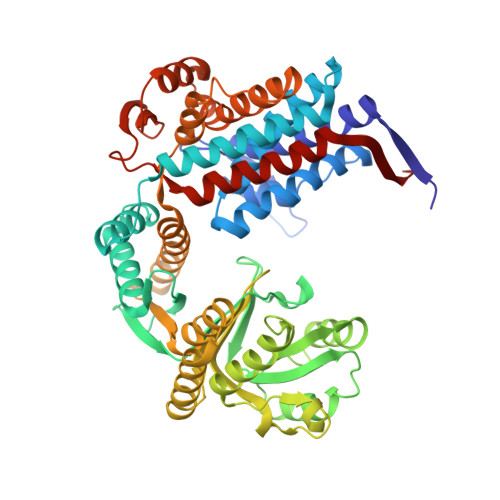Exploring the structural dynamics of the E.coli chaperonin GroEL using translation-libration-screw crystallographic refinement of intermediate states.
Chaudhry, C., Horwich, A.L., Brunger, A.T., Adams, P.D.(2004) J Mol Biol 342: 229-245
- PubMed: 15313620
- DOI: https://doi.org/10.1016/j.jmb.2004.07.015
- Primary Citation of Related Structures:
1SS8, 1SVT, 1SX3, 1SX4 - PubMed Abstract:
Large rigid-body domain movements are critical to GroEL-mediated protein folding, especially apical domain elevation and twist associated with the formation of a folding chamber upon binding ATP and co-chaperonin GroES. Here, we have modeled the anisotropic displacements of GroEL domains from various crystallized states, unliganded GroEL, ATPgammaS-bound, ADP-AlFx/GroES-bound, and ADP/GroES bound, using translation-libration-screw (TLS) analysis. Remarkably, the TLS results show that the inherent motions of unliganded GroEL, a polypeptide-accepting state, are biased along the transition pathway that leads to the folding-active state. In the ADP-AlFx/GroES-bound folding-active state the dynamic modes of the apical domains become reoriented and coupled to the motions of bound GroES. The ADP/GroES complex exhibits these same motions, but they are increased in magnitude, potentially reflecting the decreased stability of the complex after nucleotide hydrolysis. Our results have allowed the visualization of the anisotropic molecular motions that link the static conformations previously observed by X-ray crystallography. Application of the same analyses to other macromolecules where rigid body motions occur may give insight into the large scale dynamics critical for function and thus has the potential to extend our fundamental understanding of molecular machines.
Organizational Affiliation:
Department of Molecular Biophysics and Biochemistry, Yale University, New Haven, CT 06520, USA.














